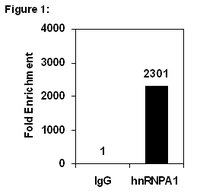03-181 Sigma-AldrichRIPAb+™ hnRNPA1 (M9 Region) - RIP Validated Antibody and Primer Set
This RIPAb+ hnRNPA1 (M9 Region) -RIP Validated Antibody & Primer Set conveniently includes the antibody & the specific control PCR primers.
More>> This RIPAb+ hnRNPA1 (M9 Region) -RIP Validated Antibody & Primer Set conveniently includes the antibody & the specific control PCR primers. Less<<Recommended Products
Overview
| Replacement Information |
|---|
Key Spec Table
| Species Reactivity | Key Applications |
|---|---|
| H | RIP, WB, IP |
| References |
|---|
| Product Information | |
|---|---|
| Format | Purified |
| Control |
|
| Presentation | Anti-hnRNPA1 (M9 Region) (Mouse Monoclonal). One vial containing 50 μg of purified antibody in 75 μL of 0.1 M Tris-Glycine (pH7.4), 150 mM NaCl with 0.05% sodium azide and 30% glycerol. Store at -20°C . Normal Mouse IgG, . One vial containing 125 µg purified mouse IgG in 125 µL storage buffer containing 0.1% sodium azide. Store at -20°C. RIP Primers, E2F3, . One vial containing 75 μL of 5 μM of each primer specific for human E2F3 mRNA. Store at -20°C. FOR: TGG TAC CAT TGA GTT GCT GCT ATT REV: AGC TCA TGT GTT GCC CTT TAT ACA |
| Quality Level | MQ100 |
| Physicochemical Information |
|---|
| Dimensions |
|---|
| Materials Information |
|---|
| Toxicological Information |
|---|
| Safety Information according to GHS |
|---|
| Safety Information |
|---|
| Packaging Information | |
|---|---|
| Material Size | 10 assays |
| Material Package | 10 assays per set. Recommended use: ~5 μg of antibody per RIP (dependent upon biological context). |
| Transport Information |
|---|
| Supplemental Information |
|---|
| Specifications |
|---|
| Global Trade Item Number | |
|---|---|
| Catalogue Number | GTIN |
| 03-181 | 04053252682292 |
Documentation
RIPAb+™ hnRNPA1 (M9 Region) - RIP Validated Antibody and Primer Set Certificates of Analysis
| Title | Lot Number |
|---|---|
| RIPAb+ hnRNPA1 (M9 Region) - NRG1841072 | NRG1841072 |
| RIPAb+ hnRNPA1 (M9 Region) -2740907 | 2740907 |
| RIPAb+ hnRNPA1 (M9 Region) Monoclonal Antibody/Primer Set | 2872388 |
| RIPAb+™ hnRNPA1 (M9 Region) - 2387855 | 2387855 |









